Sir John Monash, Personal Files Book 14, 6 October - 30 November 1916, Part 14
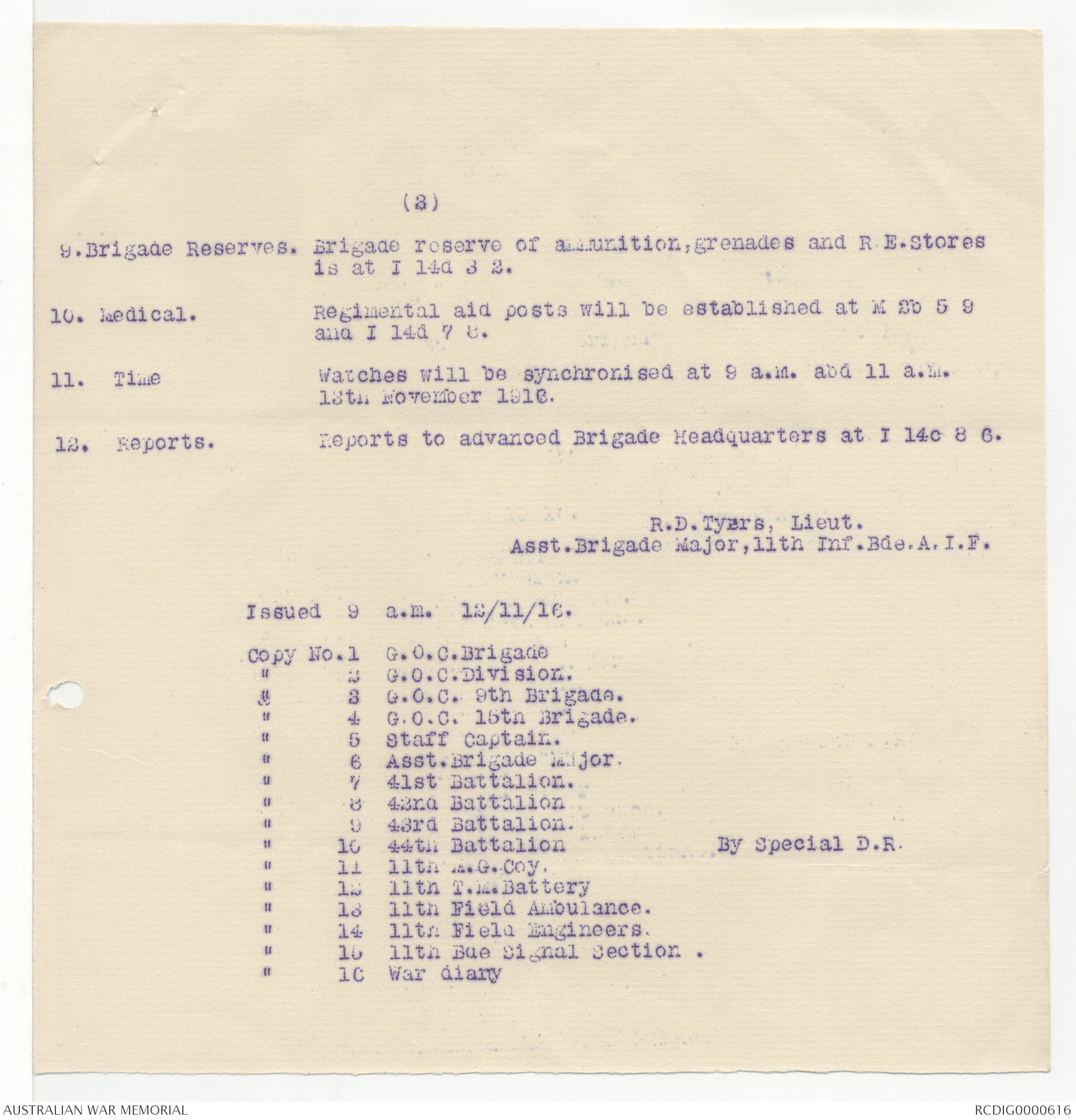
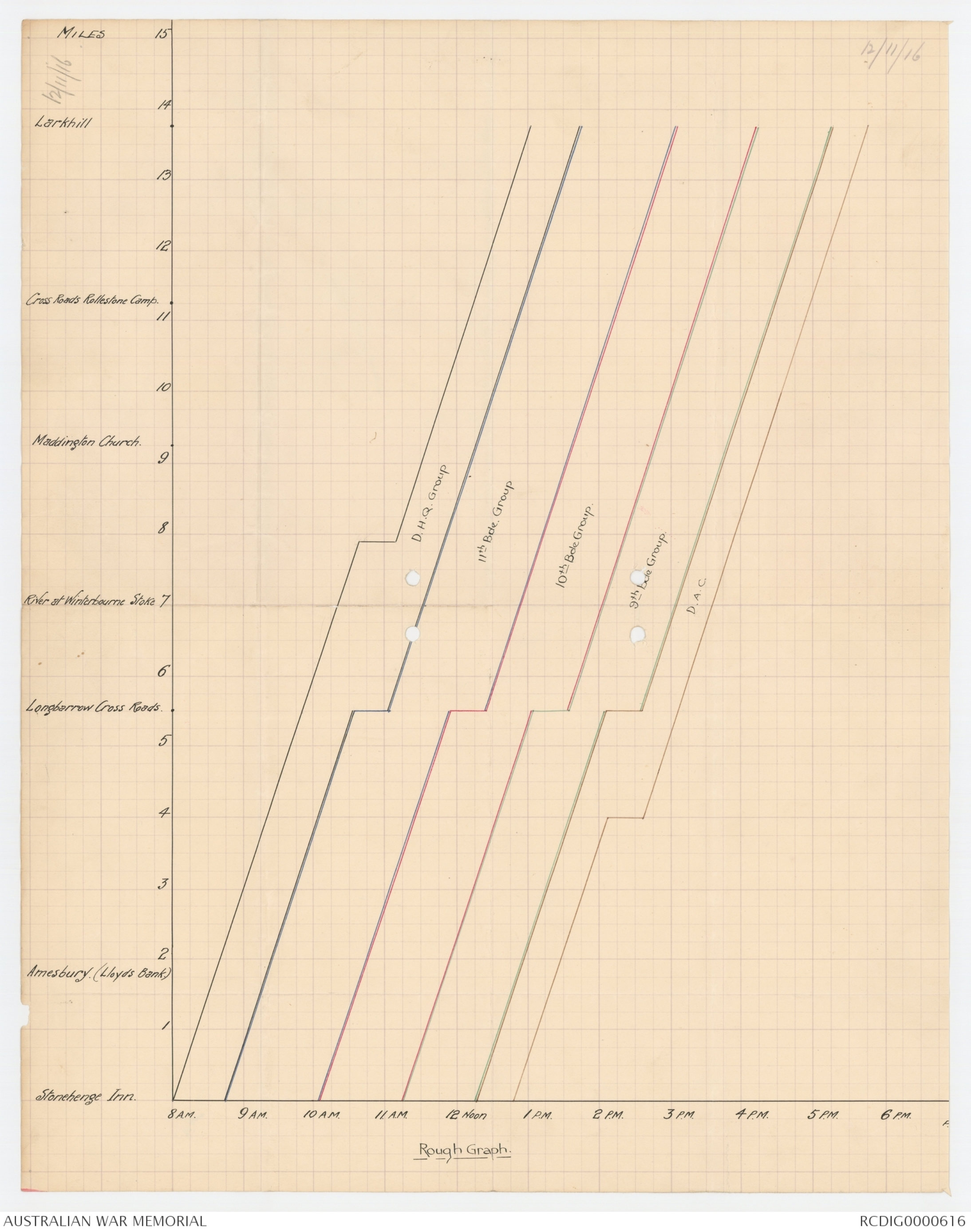
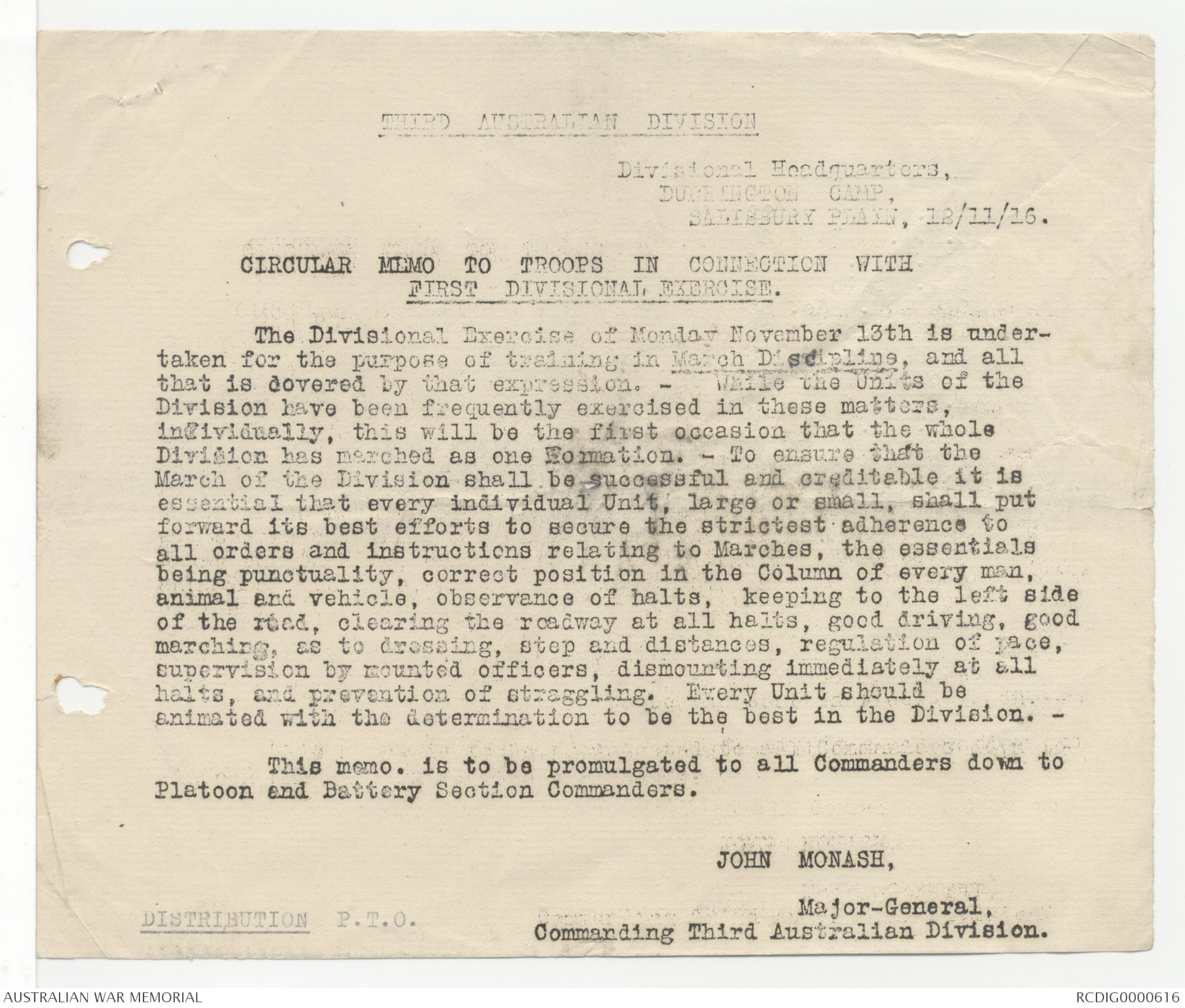
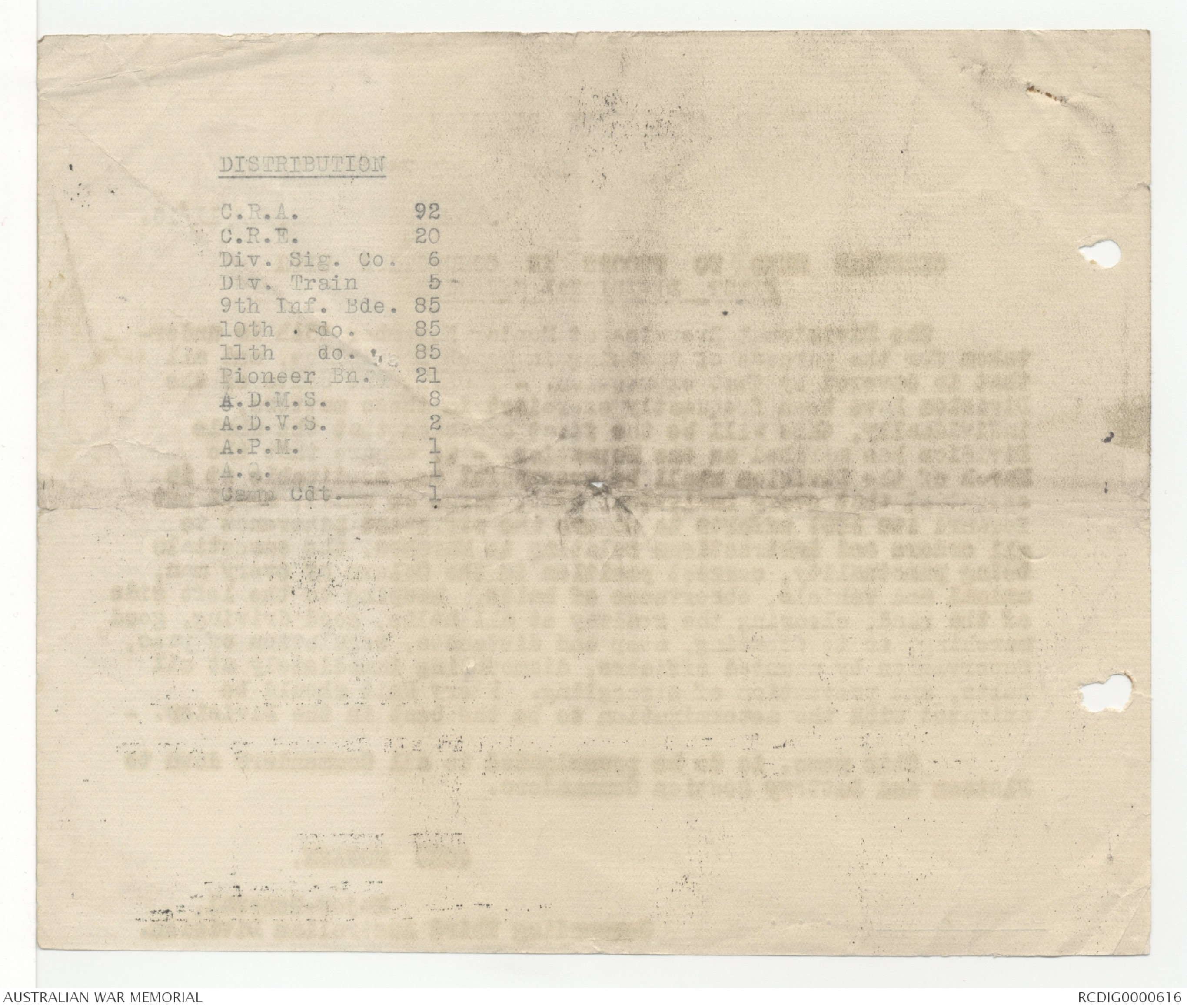
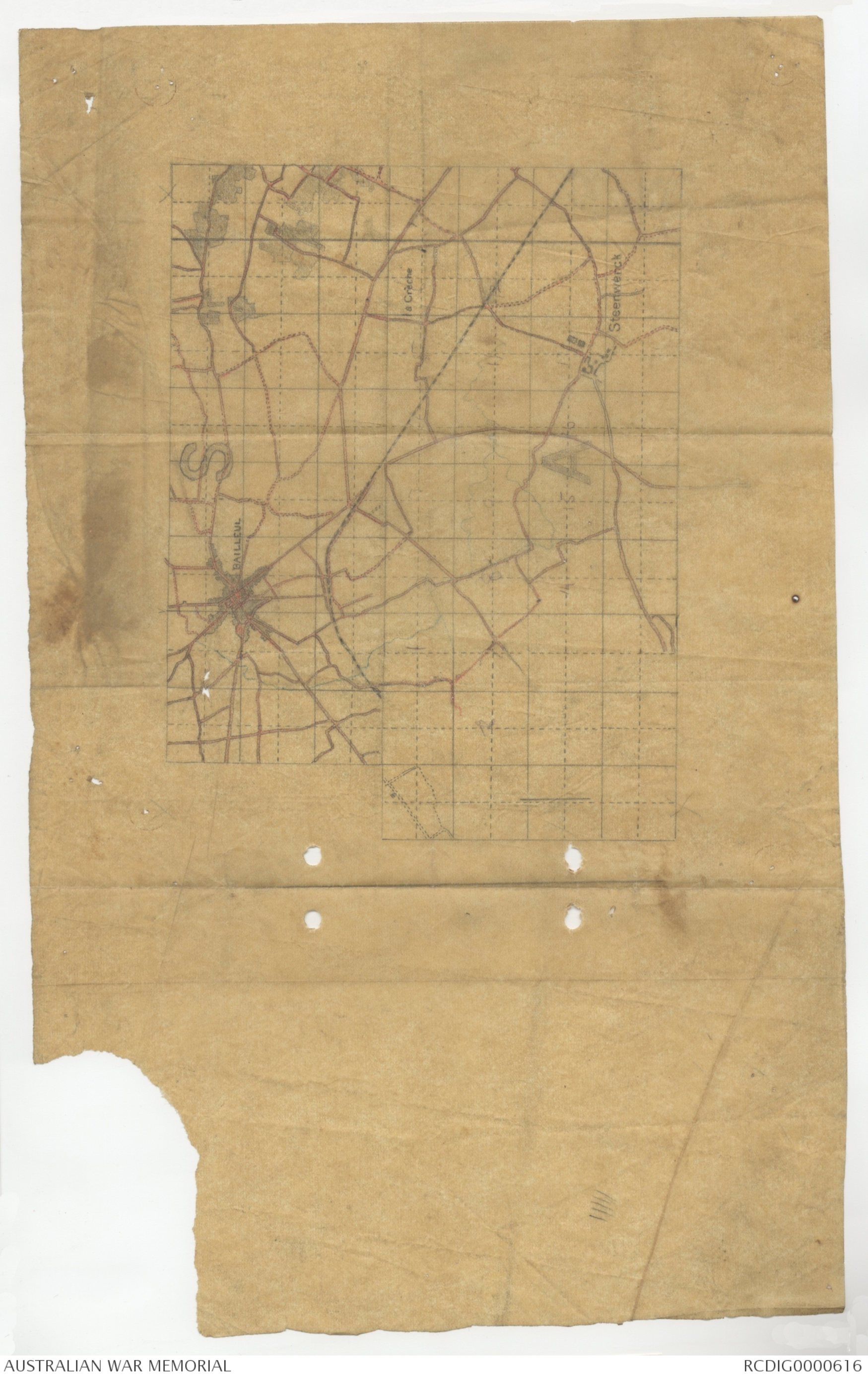
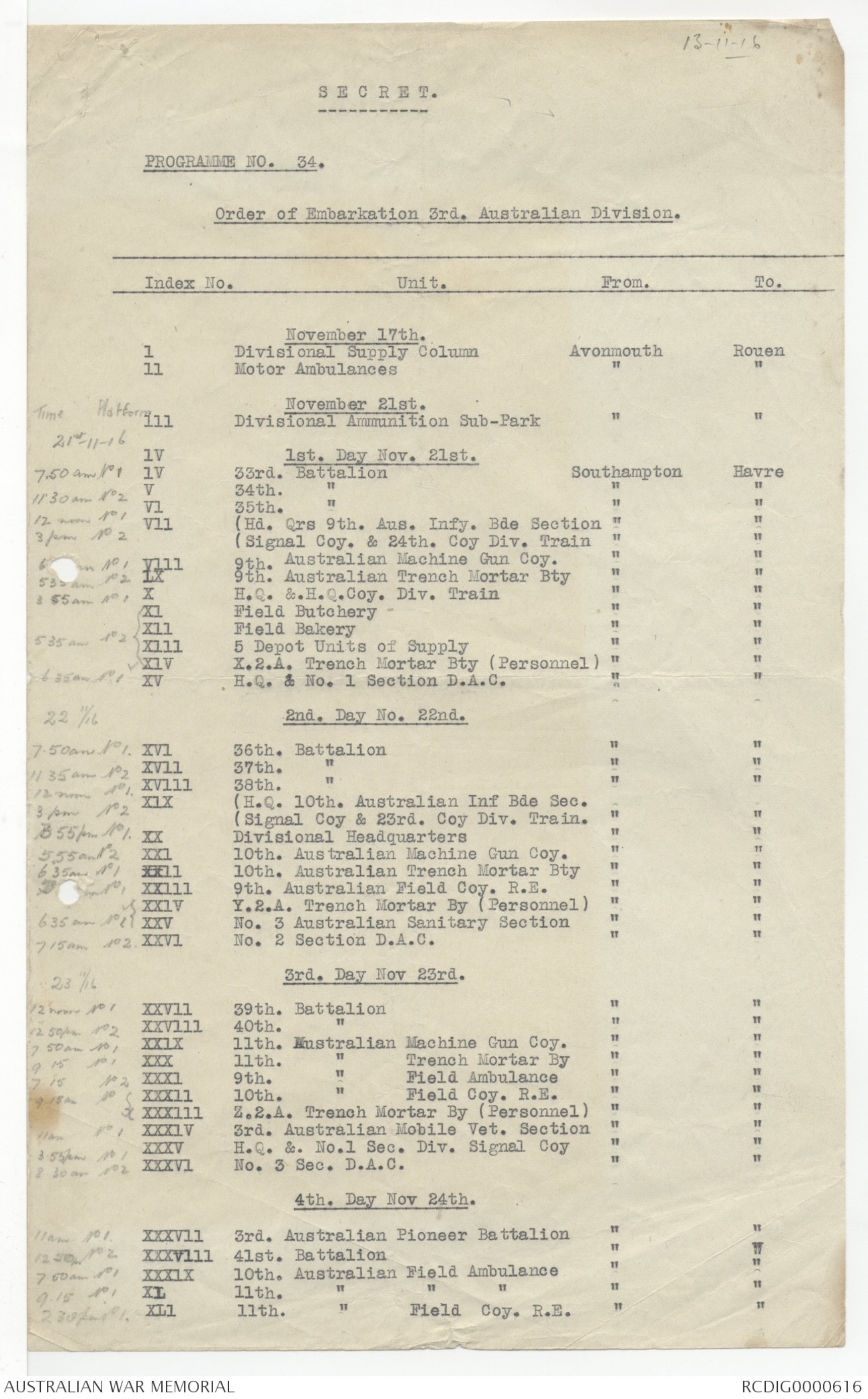
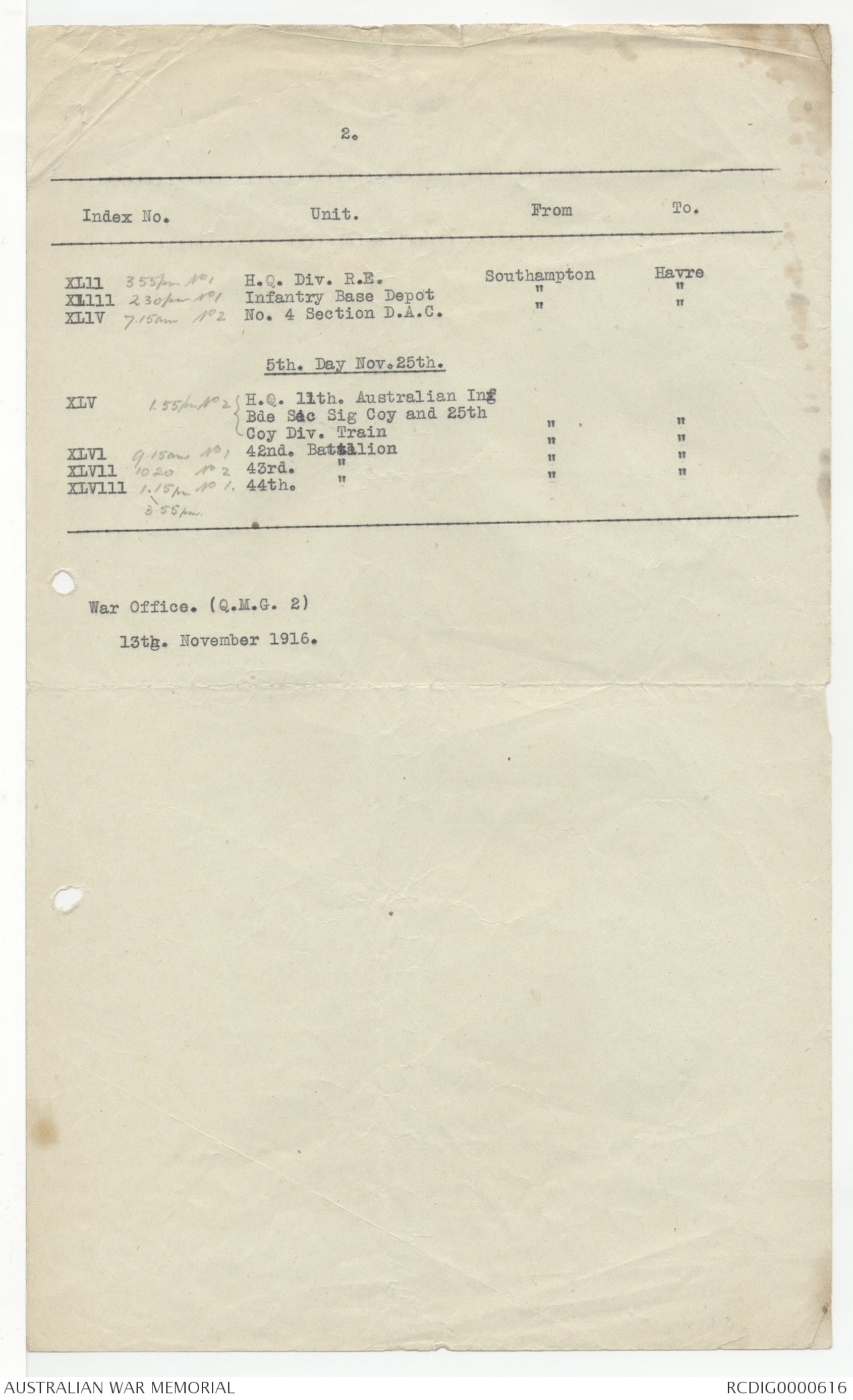
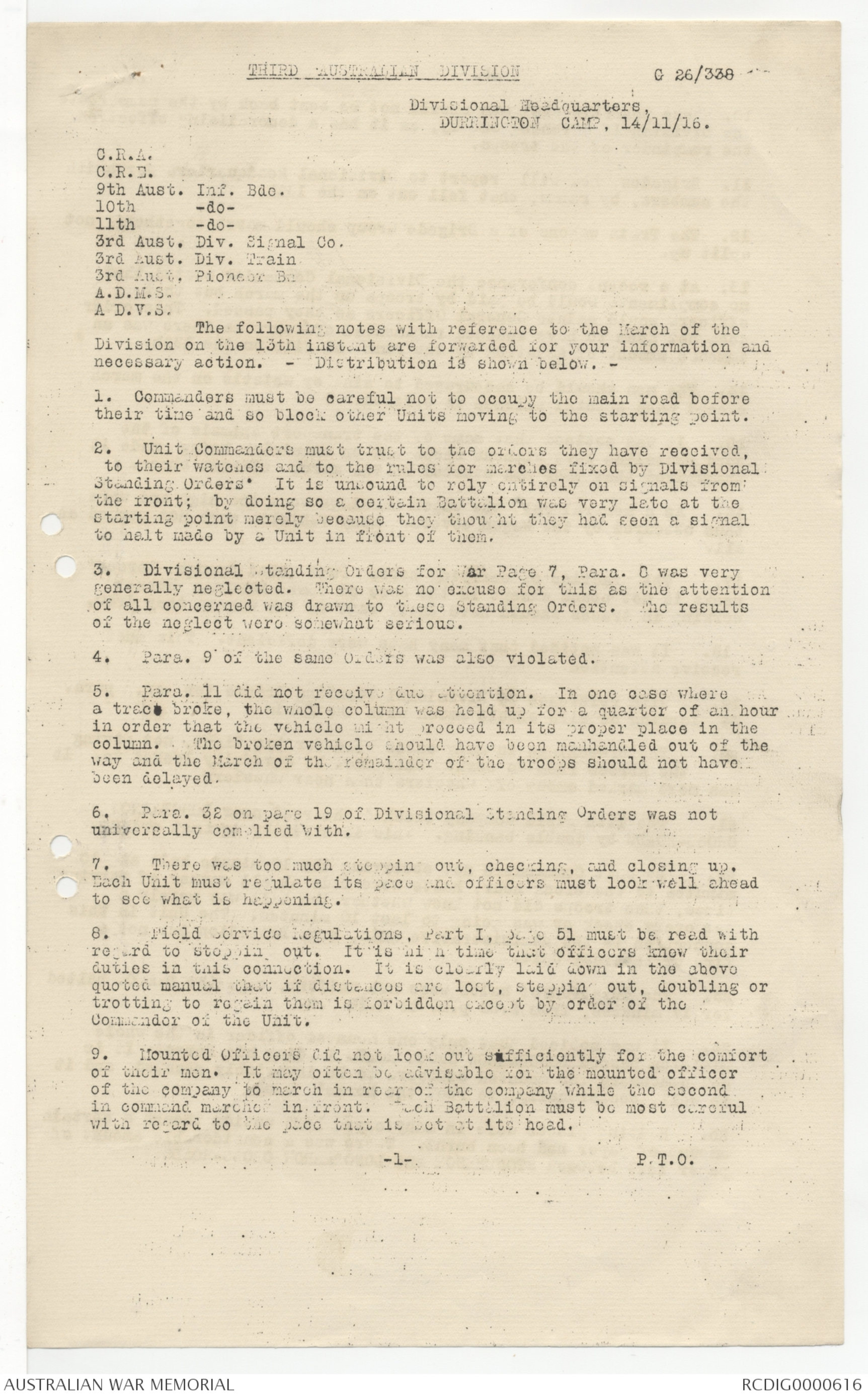
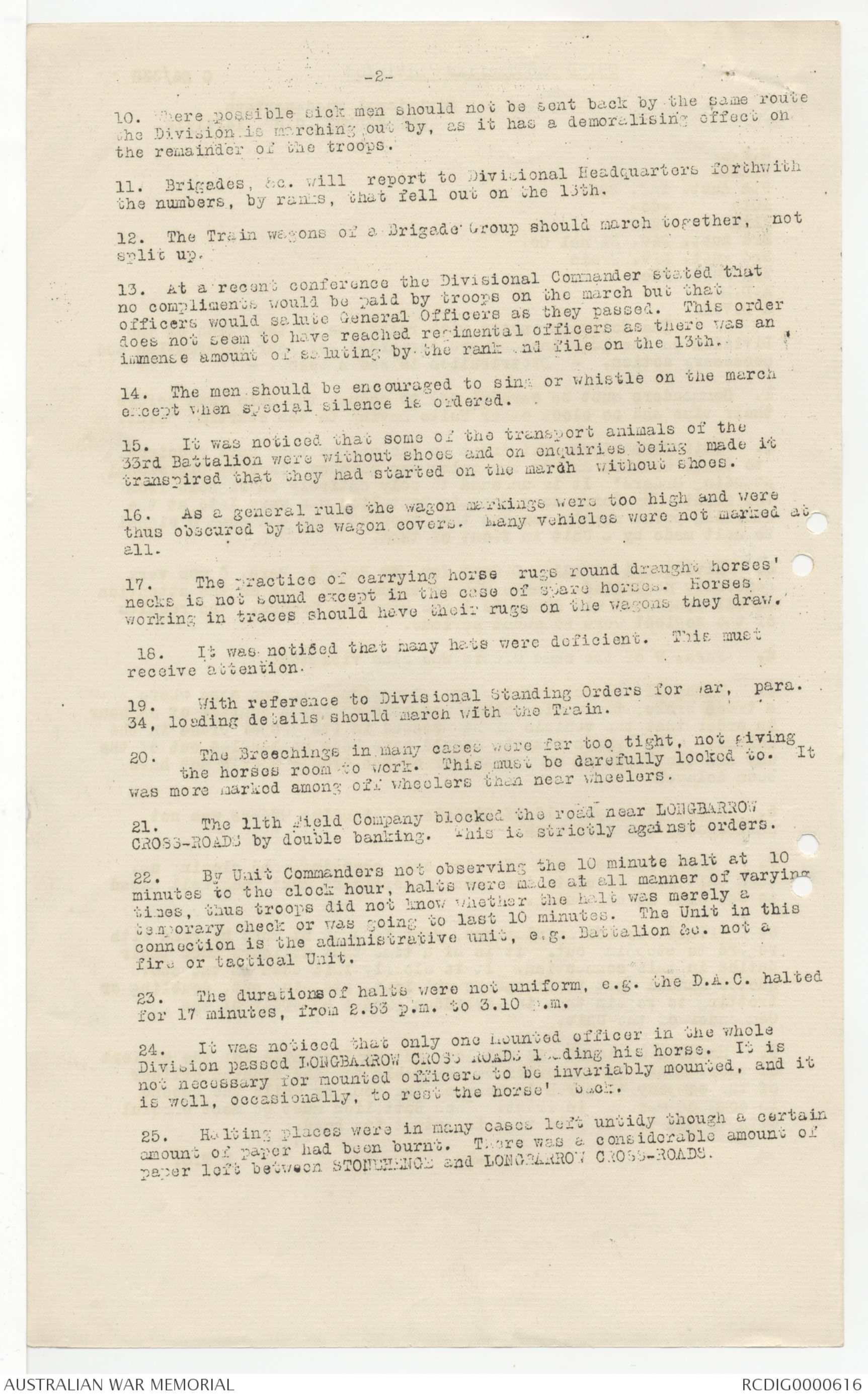
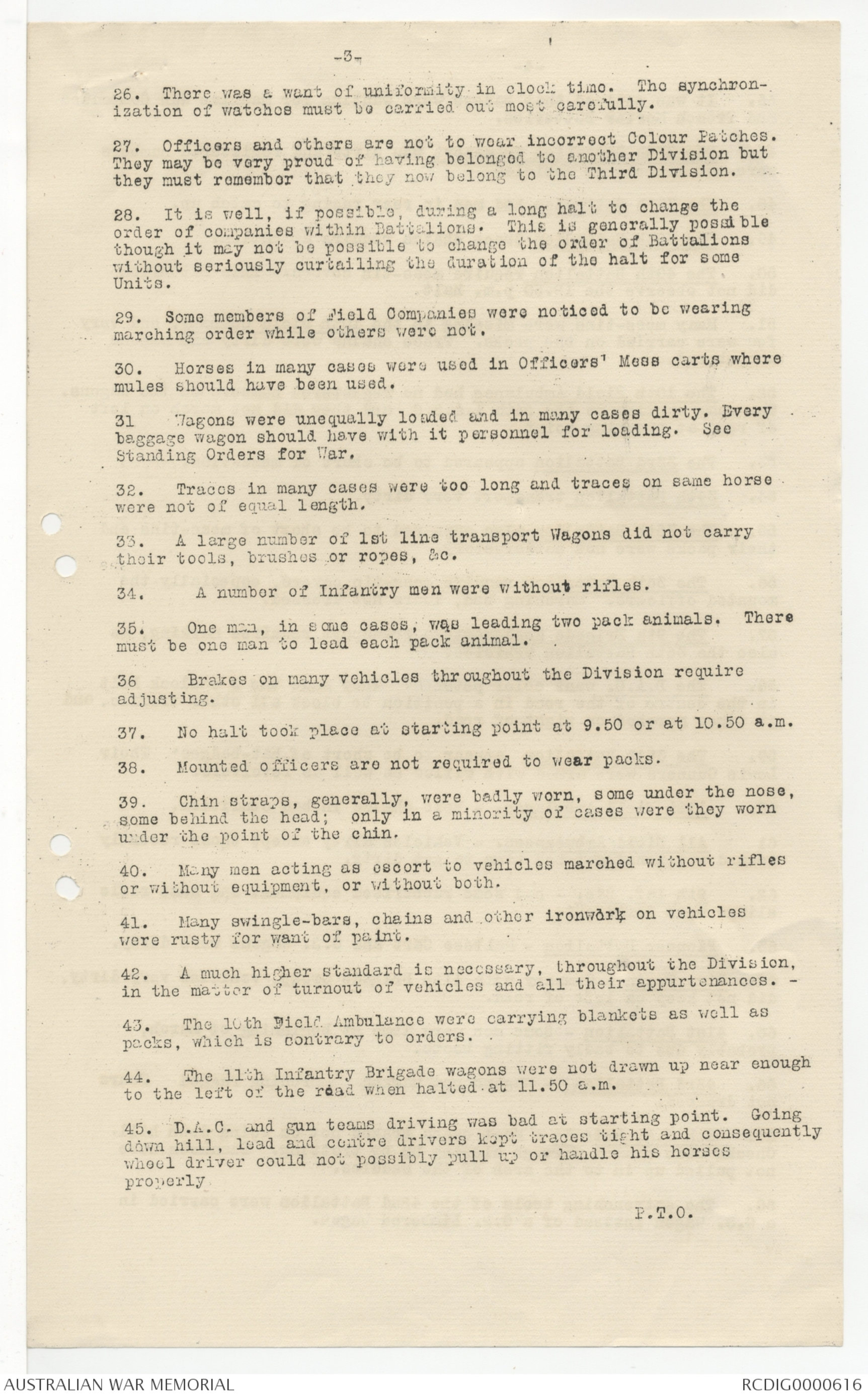
(3)
9. Brigade Reserves. Brigade reserve of ammunition, grenades
and R.E.Stores
is at I 14d 3 2.
10. Medical. Regimental aid posts will be established at M 2b 5 9
and I 14d 7 8.
11. Time Watches will be synchronised at 9 a.m. abd 11 a. m.
13th November 1916.
12. Reports. Reports to advanced Brigade
Headquarters at I 14c 8 6.
R.D.Tyers, Lieut.
Asst.Brigade Major, 11th Inf. Bde.A.I.F.
Issued 9 a.m. 12/11/16.
Copy No.1 G.O.C. Brigade
" 2 G.O.C. Division.
" 3 G.O.C. 9th Brigade.
" 4 G.O.C. 15th Brigade.
" 5 Staff Captain.
" 6 Asst. Brigade Major.
" 7 41st Battalion.
" 8 42nd Battalion
" 9 43rd Battalion.
" 10 44th Battalion By Special D.R.
" 11 11th A.G. Coy
" 12 11th T.M. Battery
" 13 11th Field Ambulance.
" 14 11th Field Engineers
" 15 11th Bde Signal Section.
" 16 War diary
Diagram - see original
MILES 15
[*12/11/16*]
14
Larkhill
13
12
Cross Roads Rollestone Camp
11
10
Maddington Church
9
8 DHQ Group
River at Winterbourne Stoke 7
6. 11th Bde. Group 10th Bde. Group 9th Bde. Group
Longbarrow Cross Roads. D.A.C.
5
4
3
2
Amesbury (Lloyds Bank)
1
Stonehenge Inn
8AM 9AM 10AM 11AM. 12 Noon 1PM 2PM 3PM 4PM 5PM 6PM
Rough Graph.
THIRD AUSTRALIAN DIVISION
Divisional Headquarters,
DURRINGTON CAMP
SALISBURY PLAIN, 12/11/16.
CIRCULAR MEMO TO TROOPS IN CONNECTION WITH
FIRST DIVISIONAL EXERCISE
The Divisional Exercise of Monday November 13th is under-
taken for the purpose of training in March Discipline, and all
that is covered by that expression.- While the Units of the
Division have been frequently exercised in these matters,
individually, this will be the first occasion that the whole
Division is marched as one Formation.- To ensure that the
March of the Division shall be successful and creditable it is
essential that every individual Unit, large or small, shall put
forward its best efforts to secure the strictest adherence to
all orders and instructions relating to Marches, the essentials
being punctuality, correct position in the Column of every man,
animal and vehicle, observance of halts, keeping to the left side
of the road, clearing the roadway at all halts, good driving, good
marching, as to dressing, step and distances, regulation of pace,
supervision by mounted officers, dismounting immediately at all
halts, and prevention of straggling. Every Unit should be
animated with the determination to be the best in the Division.-
This memo. is to be promulgated to all Commanders down to
Platoon and Battery Section Commanders.
JOHN MONASH,
Major-General,
Commanding Third Australian Division.
DISTRIBUTION P.T.O.
DISTRIBUTION
C.R.A. 92
C.R.E. 20
Div. Sig. Co. 6
Div. Train 5
9th Inf. Bde. 85
10th . do. 85
11th do. 85
Pioneer Bn. 21
A.D.M.S. 8
A.D.V.S. 2
A.P.M. 1
A.Q. 1
Camp Cdt. 1
Diagram - see original
SECRET.
PROGRAMME NO. 34.
Order of Embarkation 3rd. Australian Division.
| Index No. | Unit | From | To | |
| November 17th. | ||||
| 1 | Divisional Supply Column | Avonmouth | Rouen | |
| 11 | Motor Ambulances | " | " | |
| November 21st. | ||||
| [*Time Platform*] | 111 | Divisional Ammunition Sub-Park | " | " |
| [*21st-11-16*] | 1V | 1st Day Nov. 21st. | ||
| [*7.50am No 1*] | 1V | 33rd. Battalion | Southampton | Havre |
| [*11.30am No 2*] | V | 34th " | " | " |
| [*12noon No 1*] | V1 | 35th. " | " | " |
| [*3pm No 2*] | V11 | (Hd. Qrs 9th. Aus. Infy. Bde Section | " | " |
| (Signal Coy. & 24th. Coy. Div. Train | " | " | ||
| [*6pm No 1 *] | V111 | 9th Australian Machine Gun Coy. | " | " |
| [*5.30am. No 28] | 1X | 9th. Australian Trench Mortar Bty | " | " |
| [*3.55am No 1*] | X | H.Q. & H.Q. Coy. Div. Train | " | " |
| [*5.35am No 2*] | X1 | Field Butchery | " | " |
| X11 | Field Bakery | " | " | |
| X111 | 5 Depot Units of Supply | " | " | |
| X1V | X.2.A. Trench Mortar Bty (Personnel) | " | " | |
| [*6.35am No 1*] | XV | H.Q. & No. 1 Section D.A.C. | " | " |
| [*22 11/16*] | 2nd Day No. 22nd. | |||
| [*7.50am No 1*] | XV1 | 36th. Battalion | " | " |
| [*11.35am No 2*] | XV11 | 37th. " | " | " |
| [*12noon No 1*] | XV111 | 38th. " | " | " |
| [*3pm No 2*] | X1X |
(H.Q. 10th. Australian Inf Bde Sec. (Signal Coy & 23rd. Coy Div. Train |
" | " |
| [*3.55pm No 1*] | XX | Divisional Headquarters | " | " |
| [*5.55am No 2*] | XX1 | 10th Australian Machine Gun Coy. | " | " |
| [*6.35am No 1*] | XX11 | 10th Australian Trench Mortar Bty | " | " |
| [*? No ?*] | XX111 | 9th Australian Field Coy. R.E. | " | " |
| XX1V | Y.2.A. Trench Mortar By (Personnel) | " | " | |
| [*6.35am No 1*] | XXV | No. 3 Australian Sanitary Section | " | " |
| [*7.15am No 2*] | XXV1 | No. 2 Section D.A.C. | " | " |
| [*23 11/16*] | 3rd. Day Nov. 23rd. | |||
| [*12noon No 1*] | XXV11 | 39th. Battalion | " | " |
| [*12.50pm No 2*] | XXV111 | 40th. " | " | " |
| [*7.50am No 1*] | XX1X | 11th Australian Machine Gun Coy. | " | " |
| [*9.15 No 1*] | XXX | 11th " Trench Mortar By | " | " |
| [*7.15 No 2*] | XXX1 | 9th " Field Ambulance | " | " |
| [*9.15am No ?*] | XXX11 | 10th " Field Coy. R.E. | " | " |
| XXX111 | Z.2.A. Trench Mortar By (Personnel) | " | " | |
| [*11am No 1*] | XXX1V | 3rd. Australian Mobile Vet. Section | " | " |
| [*3.55pm No 1*] | XXXV | H.Q. & No. 1 Sec. Div. Signal Coy | " | " |
| [*2.30am No 2*] | XXXV1 | No. 3 Sec. D.A.C. | " | " |
| 4th. Day Nov 24th. | ||||
| [*11am No 1*] | XXXV11 | 3rd. Australian Pioneer Battalion | " | " |
| [*12.50pm No 2*] | XXXV111 | 41st Battalion | " | " |
| [*7.50am No 1*] | XXX1X | 10th Australian Field Ambulance | " | " |
| [*9.15 No 1*] | XL | 11th " " " | " | " |
| [*2.30pm No 1*] | XL1 | 11th " Field Coy. R.E. | " | " |
2.
| Index No. | Unit | From | To | |
| [*3.55pm No 1*] | XL11 | H.Q. Div. R.E. | Southampton | Havre |
| [*2.30pm No 1*] | XL111 | Infantry Base Depot | " | " |
| [*7.15am No 2*] | XL1V | No. 4 Section D.A.C. | " | " |
| 5th. Day Nov. 25th. | ||||
| [*1.55pm No 2*] | XLV |
H.Q. 11th. Australian Inf Bde Sec Sig Coy and 25th Coy Div. Train |
" | " |
| [*9.15am No 1*] | XLV1 | 42nd. Battalion | " | " |
| [*10.20 No 2*] | XLV11 | 43rd. " | " | " |
|
[*1.15pm No 1*] 3.55pm |
XLV111 | 44th. " | " | " |
War Office. (Q.M.G. 2)
13th. November 1916
G 26/338 -
THIRD AUSTRALIAN DIVISION. C26/338
Divisional Headquarters
DURRINGTON CAMP, 14/11/16.
C.R.A.
C.R.E.
9th Aust. Inf. Bde.
10th -do-
11th -do-
3rd Aust. Div. Signal Co.
3rd Aust. Div. Train
3rd Aust. Pioneor Br
A.D.M.S.
A D.V.S.
The following notes with reference to the March of the
Division on the l3th instant are forwarded for your information and
necessary action. - Distribution is shown below. -
1. Commanders must be careful not to occupy the main road before
their time and so block other Units moving to the starting point.
2. Unit Commanders must trust to the orders they have received,
to their watches and to the rules for marches fixed by Divisional
Standing Orders. It is unsound to rely entirely on signals from
the front; by doing so a certain Battalion was very late at the
starting point merely because they thought they had seen a signal
to halt made by a Unit in front of them.
3. Divisional Standing Orders for War Page 7, Para. 8 was very
generally neglected. There was no excuse for this as the attention
of all concerned was drawn to these Standing Orders. The results
of the neglect wero somewhat serious.
4. Para. 9 of the same Orders was also violated.
5. Para. 11 did not receive due attention. In one case where
a tract broke, the whole column was held up for a quarter of an hour
in order that the vehicle might proceed in its proper place in the
column. The broken vehicle should have been manhandled out of the
way and the March of the remainder of the troops should not have
been delayed.
6. Para. 32 on page 19 of Divisional Standing Orders was not
universally complied with.
7. There was too much stepping out, checking, and closing up.
Each Unit must regulate its pace and officers must look well ahead
to see what is happening.
8. Field Service Regulations, Part I, page 51 must be read with
regard to stepping out. It is high time that officers knew their
duties in this connection. It is clearly laid down in the above
quoted manual that if distances are lost, stepping out, doubling or
trotting to regain them is forbidden except by order of the
Commander of the Unit.
9. Mounted Officers did not look out sufficiently for the comfort
of their men. It may often be advisable for the mounted officer
of the company to march in rear of the company while the second
in command marches in front. Each Battalion must be most careful
with regard to the pace that is set at its head.
-1-
P.T.O.
-2-
10. Where possible sick men should not be sent back by the same route
the Division is morching out by, as it has a demoralising effect on
the remainder of the troops.
11. Brigades, &c. will report to Divisional Headquarters forthwith
the numbers, by ranks, that fell out on the 13th.
12. The Train wagons of a Brigade Group should march together, not
split up.
13. At a recent conference the Divisional Commander stated that
no compliments would be paid by troops on the march but that
officers would salute Ceneral Officers as they passed. This order
does not seem to have reached regimental officers as there was an
immense amount of saluting by the rank and file on the 13th.
14. The men should be encouraged to sing or whistle on the march
except when special silence is ordered.
15. It was noticed that some of the transport animals of the
33rd Battalion were without shoes and on enquiries being made it
transpired that they had started on the march without shoes.
16. As a general rule the wagon markings were too high and were
thus obscured by the wagon covers. Many vehicles were not marked at
all.
17. The practice of carrying horse rugs round draught horses'
necks is not sound except in the case of spare horses. Horses
working in traces should have their rugs on the wagons they draw.
18. It was noticed that many hats were deficient. This must
receive attention.
19. With reference to Divisional Standing Orders for War, para.
34, loading details should march with the Train.
20. The Breechings in many cases were far too tight, not giving
the horses room to work. This must be carefully looked to. It
was more marked among off wheelers than near wheelers.
21. The 11th Field Company blocked the road near LONGBARROW
CROSS-ROADS by double banking. This is strictly against orders.
22. By Unit Commanders not observing the 10 minute halt at 10
minutes to the clock hour, halts were made at all manner of varying
times, thus troops did not know whether the halt was merely a
temporary check or was going to last 10 minutes. The Unit in this
connection is the administrative unit, e.g. Battalion &c. not a
fire or tactical Unit.
23. The durations of halts were not uniform, e.g. the D.A.C. halted
for 17 minutes, from 2.53 p.m. to 3.10 p.m.
24. It was noticed that only one Mounted officer in the whole
Division passed LONGBARROW CROSS ROADS leading his horse. It is
not necessary for mounted officers to be invariably mounted, and it
is well, occasionally, to rest the horse's back.
25. Halting places were in many cases left untidy though a certain
amount of paper had been burnt. There was a considerable amount of
paper left between STONEHENGE and LONGBARROW CROSS-ROADS
-3-
26. There was a want of uniformity in clock time. The synchronisation of watches must be carried out most carefully.
27. Officers and others are not to wear incorrect Colour Patches.
They may be very proud of having belonged to another Division but
they must remember that they now belong to the Third Division.
28. It is well, if possible, during a long halt to change the
order of companies within Battalions. This is generally possible
though it may not be possible to change the order of Battalions
without seriously curtailing the duration of the halt for some
Units.
29. Some members of Field Companies were noticed to be wearing
marching order while others were not.
30. Horses in many cases were used in Officers' Mess carts where
mules should have been used.
31. Wagons were unequally loaded and in many cases dirty. Every
baggage wagon should have with it personnel for loading. See
Standing Orders for War.
32. Traces in many cases were too long and traces on same horse
were not of equal length.
33. A large number of 1st line transport Wagons did not carry
their tools, brushes or ropes, &c.
34. A number of Infantry men were without rifles.
35. One man, in some cases, was leading two pack animals. There
must be one man to lead each pack animal.
36. Brakes on many vehicles throughout the Division require
adjusting.
37. No halt took place at starting point at 9.50 or at 10.50 a.m.
38. Mounted officers are not required to wear packs.
39. Chin straps, generally, were badly worn, some under the nose,
some behind the head; only in a minority of cases were they worn
under the point of the chin.
40. Many men acting as escort to vehicles marched without rifles
or without equipment, or without both.
41. Many swingle-bars, chains and other ironwork on vehicles
were rusty for want of paint.
42. A much higher standard is neccssary, throughout the Division,
in the matter of turnout of vehicles and all their appurtenances.
43. The 10th Field Ambulance were carrying blankets as well as
packs, which is contrary to orders.
44. The 11th Infantry Brigade wagons were not drawn up near enough
to the left of the road when halted at 11.50 a.m.
45. D.A.C. and gun teams driving was bad at starting point. Going
down hill, lead and centre drivers kept traces tight and consequently
wheel driver could not possibly pull up or handle his horses
properly
P.T.0.
 Upty
UptyThis transcription item is now locked to you for editing. To release the lock either Save your changes or Cancel.
This lock will be automatically released after 60 minutes of inactivity.